Round 1, 2007
Back in 2007 I read a few articles about the merits of stand-up desks, in regards to health and productivity. According to the New York Times and other sources, standing desks have been not quite common, but neither terribly uncommon, for many years. Sitting all the time is apparently quite unhealthy. Famously, Donald Rumsfeld used one, and maybe it helped him come up with this?
There are known knowns. These are things we know that we know. There are known unknowns. That is to say, there are things that we know we don’t know. But there are also unknown unknowns. There are things we don’t know we don’t know.
(This quote got a lot of chuckles, including from me; but it is actually a good and important point. I wish someone less politically charged had popularized it. Many commentators suggest that Rumsfeld’s phrasing and concern for unknown unknowns came from Werner Erhard, himself a very smart but somewhat odd fellow.)
Inspired to try out standing up at work, I set up perhaps the world’s ugliest standing desk:

I took an old and already-ugly normal desk, and put it on primitive stilts constructed in about 30 minutes for about $10. This was marginally acceptable for the out-of-the-way room I was using as a home office at the time. To make the most of things, I took the photo above with plenty of semi-obsolete technology and ample wiring in view. Looking back at this photo, I observe that my wife is an amazingly tolerant and loving woman.
In spite of the poor aesthetics, I enjoyed this desk for many months, and noticed an increase in my productivity and focus, discussed more at the end of this post. At the same time, some minor backaches and pains went away, and I slept better. (Be warned though, that it takes some getting used to, the first couple of weeks are tough.)
Functionally speaking, the only weakness of this arrangement was that the monitors were not high enough relative to the keyboard height.
This first-generation experiment fell into disuse when I set up a new home office with tasteful solid wood furniture and other decor, in a prominent front room of my home, at “only” 10x the cost of my old home office. The desk above went to the offices of my old firm where a couple of people tried it out, then eventually discarded it. (My new home office is not pictured here; it looks approximately like a page in the catalog of a furniture store – nice, tasteful, boring. It also contains much better hardware.)
Round 2, 2010
Inspired again by further press coverage, I’m trying out a standing desk again in 2010. I looked around at various power-adjustable desks from GeekDesk, Anthro, and Relax the Back. These have several problems:
- While I’m willing to spend what it takes, power adjustable desks are a bit costly for an experiment. None of them are a model of desk I’d want anyway for sitting.
- They only solve the keyboard height problem (the main desk surface height), they generally don’t address the height of the monitors at all. (However, Anthro has solutions for this.)
- They are much deeper than I need.
Instead, at the beginning of May I set up another homegrown (and slightly less visually offensive) arrangement:

This setup is also quite cheap, around $150 total. It is a metal shelf/rack, with an extra protruding MDF shelf screwed on to form a keyboard/mouse surface. The shelves are all adjustable, so I moved the top (computer/screen) and middle (keyboard/most) shelves up and down a few times to find the most comfortable heights: I look straight ahead at the screens, and my elbows at at 90 degrees (wrists straight) while typing. (Update: Jeremy, a reader, set up something similar.)
I wired up some leftover accessories (display, keyboard, mouse, etc. – my good stuff is in my home office, try not to laugh at the use of a spare low-end Microsoft mouse and small monitor with my MBP). This includes a very old printer that I pulled out of storage, partly as ballast and partly to just see if it still works. (It does, but an HP LaserJet 1100 is terribly slow by today’s standards, and I may replace the whole thing when my toner on hand runs out. A personal printer at my desk is more convenient than the better printers a short walk away.)
I located this at my “work” office away from home, so as not to re-test the tolerance of the above-mentioned wife. My time is split between home and work offices, and occasionally cafes, so I stand perhaps 20 hours per week on average. Even when at the standing desk, I’ll grab a nearby chair to make a phone call.
The Standing Experience
Relative to sitting, I’ve noticed a number of benefits:
- I focus more completely on my work, with less tendency to become distracted.
- More specifically, I write more (text, code) and read less.
- My back, and whole body feed better, aside from that first week.
- I move around, shifting weight, standing on one foot for a moment, etc.; I experience no stiffness or aches that sometimes result from hours of sitting.
- My urge to go buy a new chair went away; I already have a good chair in my home office, and rarely sit while at work.
In summary, this seems like a fairly substantial win, one month in to the experiment. I’ll report back later this year.
A bit of commentary: lots of people talk about their standing desks with some degree of bravado. That is entirely unjustified; outside of office workers, a large portion of the workforce spends most of every day standing and working. It’s the traditional sitting office worker who is doing something unusual.

